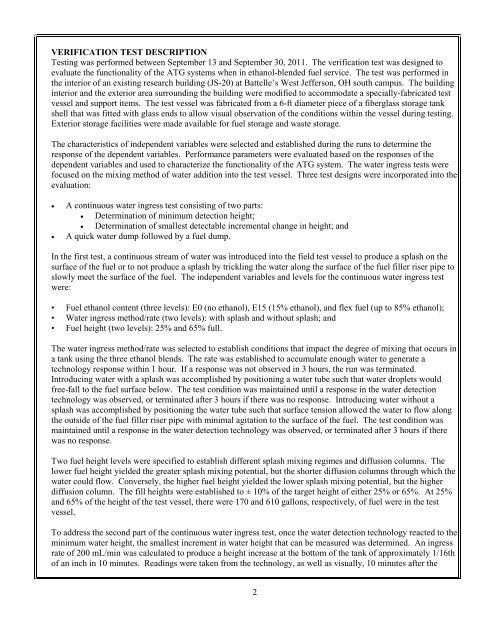Franklin Fueling Systems TSP-IGF4 Water Float - NSCEP | US EPA ...
Franklin Fueling Systems TSP-IGF4 Water Float - NSCEP | US EPA ...
Franklin Fueling Systems TSP-IGF4 Water Float - NSCEP | US EPA ...
You also want an ePaper? Increase the reach of your titles
YUMPU automatically turns print PDFs into web optimized ePapers that Google loves.
VERIFICATION TEST DESCRIPTION<br />
Testing was performed between September 13 and September 30, 2011. The verification test was designed to<br />
evaluate the functionality of the ATG systems when in ethanol-blended fuel service. The test was performed in<br />
the interior of an existing research building (JS-20) at Battelle’s West Jefferson, OH south campus. The building<br />
interior and the exterior area surrounding the building were modified to accommodate a specially-fabricated test<br />
vessel and support items. The test vessel was fabricated from a 6-ft diameter piece of a fiberglass storage tank<br />
shell that was fitted with glass ends to allow visual observation of the conditions within the vessel during testing.<br />
Exterior storage facilities were made available for fuel storage and waste storage.<br />
The characteristics of independent variables were selected and established during the runs to determine the<br />
response of the dependent variables. Performance parameters were evaluated based on the responses of the<br />
dependent variables and used to characterize the functionality of the ATG system. The water ingress tests were<br />
focused on the mixing method of water addition into the test vessel. Three test designs were incorporated into the<br />
evaluation:<br />
• A continuous water ingress test consisting of two parts:<br />
• Determination of minimum detection height;<br />
• Determination of smallest detectable incremental change in height; and<br />
• A quick water dump followed by a fuel dump.<br />
In the first test, a continuous stream of water was introduced into the field test vessel to produce a splash on the<br />
surface of the fuel or to not produce a splash by trickling the water along the surface of the fuel filler riser pipe to<br />
slowly meet the surface of the fuel. The independent variables and levels for the continuous water ingress test<br />
were:<br />
• Fuel ethanol content (three levels): E0 (no ethanol), E15 (15% ethanol), and flex fuel (up to 85% ethanol);<br />
• <strong>Water</strong> ingress method/rate (two levels): with splash and without splash; and<br />
• Fuel height (two levels): 25% and 65% full.<br />
The water ingress method/rate was selected to establish conditions that impact the degree of mixing that occurs in<br />
a tank using the three ethanol blends. The rate was established to accumulate enough water to generate a<br />
technology response within 1 hour. If a response was not observed in 3 hours, the run was terminated.<br />
Introducing water with a splash was accomplished by positioning a water tube such that water droplets would<br />
free-fall to the fuel surface below. The test condition was maintained until a response in the water detection<br />
technology was observed, or terminated after 3 hours if there was no response. Introducing water without a<br />
splash was accomplished by positioning the water tube such that surface tension allowed the water to flow along<br />
the outside of the fuel filler riser pipe with minimal agitation to the surface of the fuel. The test condition was<br />
maintained until a response in the water detection technology was observed, or terminated after 3 hours if there<br />
was no response.<br />
Two fuel height levels were specified to establish different splash mixing regimes and diffusion columns. The<br />
lower fuel height yielded the greater splash mixing potential, but the shorter diffusion columns through which the<br />
water could flow. Conversely, the higher fuel height yielded the lower splash mixing potential, but the higher<br />
diffusion column. The fill heights were established to ± 10% of the target height of either 25% or 65%. At 25%<br />
and 65% of the height of the test vessel, there were 170 and 610 gallons, respectively, of fuel were in the test<br />
vessel.<br />
To address the second part of the continuous water ingress test, once the water detection technology reacted to the<br />
minimum water height, the smallest increment in water height that can be measured was determined. An ingress<br />
rate of 200 mL/min was calculated to produce a height increase at the bottom of the tank of approximately 1/16th<br />
of an inch in 10 minutes. Readings were taken from the technology, as well as visually, 10 minutes after the<br />
2















